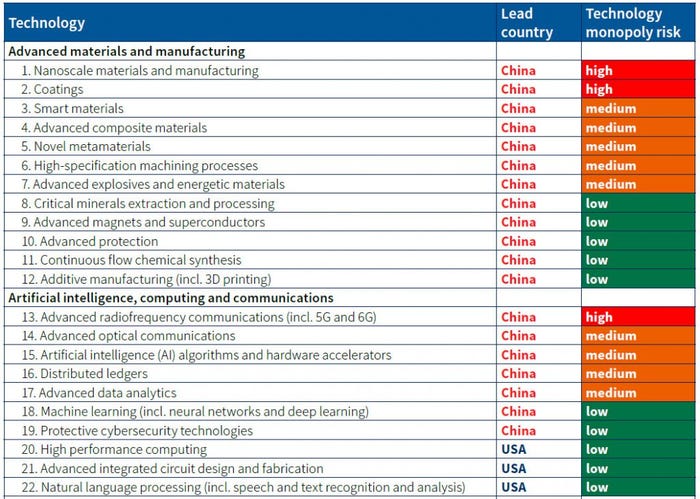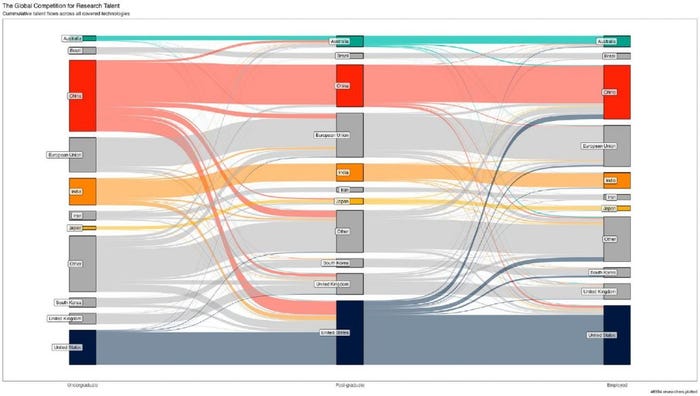China is miles ahead in telecoms researchChina is miles ahead in telecoms research
A new report from the Australian Strategic Policy Institute rings alarm bells about China’s clear R&D lead in all things telecoms.
March 6, 2023

A new report from the Australian Strategic Policy Institute rings alarm bells about China’s clear R&D lead in all things telecoms.
The report was released last week and covered by Light Reading. The headline finding is that “Western democracies are losing the global technological competition, including the race for scientific and research breakthroughs, and the ability to retain global talent.” In 37 out of 44 technology areas analysed, China is the R&D leader, often by a long distance.
As you can see from the image below, taken from an appendix of the report, China has such a lead in 5G and 6G ‘high-impact research output’ that the ASPI reckons there’s a high possibility of it establishing a global monopoly in that area. The risk of that is only slightly lower on the optical side and China leads in all areas of ICT R&D apart from HPC, chips and NLP. This revelation adds context to the US initiative to deprive China of its semiconductor expertise.

Drilling down into the telecoms findings, the report reckons China accounts for 29.7% of advanced radio frequency communications research, with the US a distant second at 9.5% and the UK third with 5.2%. On the optical side the numbers are 37.7% for China, 12.8% for the US and 5.7% for the UK.
On the talent side, the picture is a bit more nuanced. The graphic below shows the global flow of techie talent and reveals that, while China dominates at the undergraduate level, almost half of those graduates subsequently clear off to the US, Europe and elsewhere. Some of them eventually return to China to work, but that final column is a lot more balanced.

Coincidentally, the UK’s University of Birmingham today announced it has developed a new type of high performance ‘phase shifter’ for use in advanced phase array antenna systems. Using a liquid Gallium alloy (pictured, top), it varies the phase angle of microwave and millimetre-wave radio signals, which presumably has a role in compensating for their poor propagation characteristics.
The research was led by Dr Yi Wang from Birmingham’s School of Engineering, who got his BSc and MSc in Physics from the University of Science and Technology Beijing, China, but his PhD in Electronic and Electrical Engineering from the University of Birmingham.
“An ideal phase shifter would provide a stable, and wide phase angle range with a minimal loss of signal over the operation bandwidth,” said Dr Wang. “However conventional phase shifters suffer from signal losses which increase as the phase angle increases, and the phase varies with frequency. Taken together, these issues can cause signal degradation and impair performance. Rectifying this requires additional complicated circuitry and consumes more power, which adds to both the bulk and the running cost of the entire antenna.”
It’s hard to know what to take from the ASPI report. Superficially, it’s shocking (but not necessarily surprising) how much further ahead China is in so many areas. On the other hand, does its undergraduate lead necessarily translate into the real world? The report notes China’s political system is a contributor to this R&D advantage but, it seems, may also lead to some of that talent choosing to emigrate. And, as we saw last week at MWC, monetising the telecoms tech you own is becoming increasingly difficult.
Get the latest news straight to your inbox. Register for the Telecoms.com newsletter here.
About the Author
You May Also Like









.png?width=300&auto=webp&quality=80&disable=upscale)


_1.jpg?width=300&auto=webp&quality=80&disable=upscale)